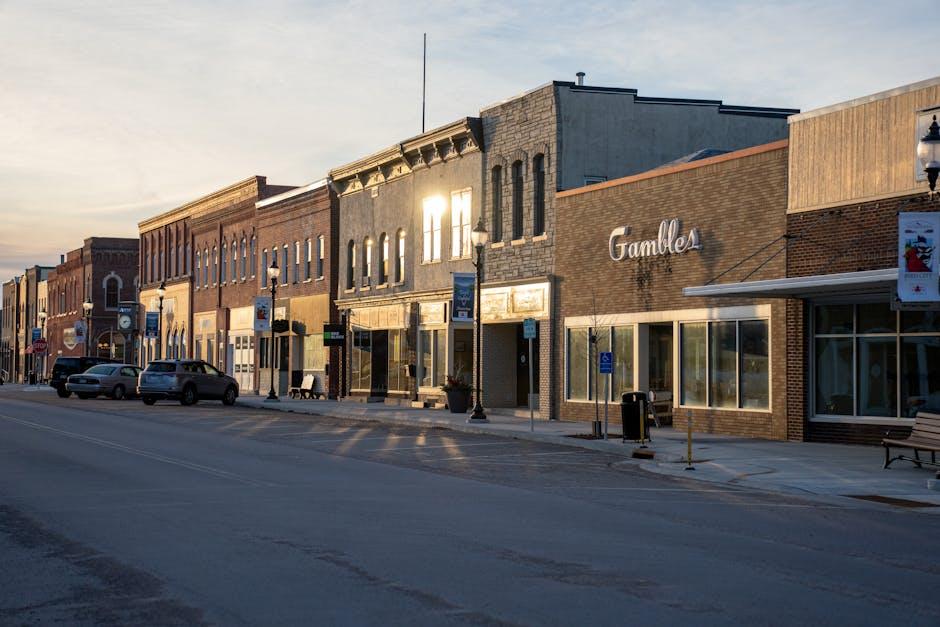In the heart of Minnesota’s bustling retail landscape, storefronts are not just gateways to goods-they’re bridges to inclusivity. As businesses strive to welcome every customer, the role of ADA-compliant locks emerges as a quiet yet crucial champion of accessibility. These locks, designed with precision and purpose, ensure that entryways are navigable for all individuals, regardless of physical ability. This article delves into the importance of ADA-compliant locking systems for Minnesota storefronts, exploring how they blend security with accessibility to create environments where every visitor feels truly welcome.
Table of Contents
- Understanding ADA Compliance Requirements for Minnesota Storefront Locks
- Key Features to Look for in ADA-Compliant Locks
- Evaluating the Best Lock Types for Easy Accessibility
- Installation Tips to Ensure Full ADA Compliance
- Recommended Brands and Models for Minnesota Retailers
- Q&A
- The Way Forward

Understanding ADA Compliance Requirements for Minnesota Storefront Locks
Ensuring that storefront locks meet the American Disabilities Act (ADA) standards is more than a regulatory obligation-it’s a commitment to *inclusive accessibility* in Minnesota’s commercial spaces. Fundamentally, locks must be operable with one hand without tight grasping, pinching, or twisting of the wrist. This means selecting locks with lever handles or push/pull mechanisms that facilitate ease of use for individuals with limited hand strength or dexterity. Additionally, the height and placement of locking devices should be within the accessible reach range-typically 34 to 48 inches from the ground-to accommodate wheelchair users.
Compliance also extends to the clear space around the doorway to allow maneuverability. It’s important to remember the following:
- Lock usability: Minimum force of 5 pounds to operate the lock.
- Visual contrast: Locks should contrast with the door surface for visibility.
- Manual operation: No complicated key sequences or timed releases.
| Requirement | Description | Recommended Lock Type |
|---|---|---|
| Operability | One-handed use without twisting or tight grasping | Lever handle lock |
| Reach Range | 34-48 inches from floor | Standard installation height |
| Visual Contrast | High contrast between lock and door | Dark-colored lever on light door |

Key Features to Look for in ADA-Compliant Locks
When selecting locks for storefronts that meet ADA standards, durability and ease of use must be at the forefront. ADA-compliant locks are designed to accommodate individuals with varying physical abilities, ensuring everyone can access your business without difficulty. Key aspects include lever handles or push/pull mechanisms that eliminate the need for tight grasping or twisting motions, and locks that require minimal force – ideally less than 5 pounds – to operate. These features not only support accessibility but also enhance overall usability for all customers.
Additionally, consider locks with clearly visible and tactile indicators, so customers can easily identify whether a door is locked or unlocked. Smart integration features, like automatic locking and remote access, can also provide an extra layer of convenience without compromising compliance. Here’s a quick overview of essential features for ADA-compliant locks:
- Low operating force: Minimal pressure needed to engage the lock
- Accessible design: Handles and levers suited for all ranges of hand motion
- Visual and tactile cues: Easy to understand lock status
- Durable materials: Built for heavy use and adverse weather
- Secure mounting: Ensures stability and safety

Evaluating the Best Lock Types for Easy Accessibility
When selecting locks for storefronts that comply with ADA standards, ease of use is paramount. Traditional key-only locks can pose challenges for individuals with limited hand dexterity or strength. Instead, consider options such as lever handles, push bars, and keypad entry systems. Lever handles, for instance, provide a smooth, downward motion that requires less precision and force, making them accessible to a broader range of users. Keypad systems, especially those with large, tactile buttons, minimize the need for physical keys and reduce the risk of fumbling, which benefits all patrons, including those with visual impairments or arthritis.
Below is a comparison table highlighting common lock types against essential ADA criteria:
| Lock Type | Ease of Use | Force Required | Recommended For |
|---|---|---|---|
| Lever Handle | High | Low | General Accessibility |
| Push Bar | Very High | Minimal | Emergency Exits, High Traffic |
| Keypad Entry | Moderate | Low | Secure Access |
| Deadbolt | Low | High | Security-Focused |
By thoughtfully choosing lock types that prioritize accessibility alongside security, Minnesota storefronts can create welcoming environments for all visitors. Incorporating features like tactile buttons, audible feedback, or power-assisted mechanisms further enhances user experience while ensuring compliance with ADA requirements.

Installation Tips to Ensure Full ADA Compliance
When selecting and installing locks for ADA compliance, it’s essential to prioritize ease of use for all individuals. Ensure that lock mechanisms require minimal force-typically no more than 5 pounds-to operate. Lever handles are preferable to knobs as they accommodate users with limited hand dexterity. Additionally, consider the height at which locks are installed: positioning them between 34 and 48 inches from the ground maximizes accessibility for wheelchair users and those with varied physical capabilities.
To further guarantee compliance, conduct routine testing after installation. Verify the lock’s functionality through real-world simulation using mobility aids like wheelchairs or walkers. Adhering to these basic principles helps you avoid costly adjustments and enhances customer satisfaction. Below is a quick reference chart outlining key ADA lock installation requirements:
| Requirement | Specification | Reason |
|---|---|---|
| Maximum Operating Force | 5 lbs (22.2 N) | Ease of use for limited strength users |
| Handle Type | Lever | Accessible grip for all users |
| Mounting Height | 34-48 inches | Accessible reach range |
| Clear Floor Space | 30 x 48 inches | Space for maneuvering wheelchair or mobility device |

Recommended Brands and Models for Minnesota Retailers
When selecting locks to meet ADA standards while ensuring durability for Minnesota’s varying climate, certain brands consistently stand out. Schlage offers a range of models that blend accessibility with sturdy construction, perfect for retail entrances. Their ND Series is designed with lever handles that require minimal force, facilitating ease of use for all customers. Another notable brand is Kwikset, known for its SmartKey technology and ADA-compliant lever options that simplify accessibility without compromising security.
For a quick comparison, consider the following options that marry ADA compliance with reliability:
| Brand | Model | Feature | Weather Resistance |
|---|---|---|---|
| Schlage | ND Series | Low-force lever handles | High (All-weather grade) |
| Kwikset | Juno Lever | SmartKey re-key technology | Moderate |
| Yale | Assure Lever | Keyless touchscreen option | High |
To ensure compliance and usability, retailers should look for models with lever handles that do not require tight grasping or twisting, meeting ADA guidelines perfectly while standing up to Minnesota’s snow and humidity. Brands like Yale and Assa Abloy also provide models engineered for smooth operation and longevity, balancing accessibility with protection.
Q&A
Q&A:
Q1: What does ADA compliance mean for storefront locks in Minnesota?
A1: ADA compliance refers to meeting the standards set by the Americans with Disabilities Act, ensuring that locks on storefronts are accessible and usable by everyone, including people with disabilities. In Minnesota, this means locks must be easy to operate without tight grasping, pinching, or twisting of the wrist.
Q2: Why are ADA-compliant locks important for Minnesota storefronts?
A2: ADA-compliant locks ensure equal access for all customers, including those with physical limitations. They help businesses stay legally compliant, avoid fines, and foster an inclusive environment that welcomes everyone.
Q3: What types of locks are typically ADA-compliant?
A3: ADA-compliant locks often include lever handles, push/pull bars, and electronic locks with accessible keypads or touchless entry systems. These designs minimize physical effort and enhance convenience.
Q4: Are there specific Minnesota regulations beyond the ADA for storefront locks?
A4: Minnesota generally follows federal ADA guidelines for accessibility. However, local building codes or city ordinances might add specific requirements, so it’s wise to consult local authorities or a professional locksmith.
Q5: How can Minnesota business owners ensure their locks are ADA-compliant?
A5: Business owners should consult with certified locksmiths or accessibility experts who can assess current locks, recommend necessary modifications, and install compliant hardware that fits both regulatory and aesthetic needs.
Q6: What challenges might Minnesota storefronts face when upgrading to ADA-compliant locks?
A6: Challenges can include balancing security with accessibility, retrofitting older doors without damaging historic features, and managing costs. However, many modern lock solutions are designed to address these concerns effectively.
Q7: Are ADA-compliant locks only about physical ease of use?
A7: While ease of use is central, ADA-compliant locks also consider visibility, tactile feedback, and operational force, ensuring that locks are accessible to people with visual impairments or reduced strength.
Q8: Can ADA-compliant locks improve overall customer experience?
A8: Absolutely. Accessible locks reduce barriers, making storefronts more inviting and easy to navigate for all patrons, enhancing satisfaction and potentially boosting business.
Q9: Where can Minnesota businesses find ADA-compliant lock products?
A9: Many locksmiths, hardware suppliers, and security companies in Minnesota offer ADA-compliant lock options. Online retailers also provide a wide range, but professional installation is recommended to ensure compliance.
Q10: What’s the first step for a Minnesota storefront to begin ADA lock compliance?
A10: Start with an accessibility audit that includes the evaluation of door hardware. This identifies non-compliant locks and helps create an upgrade plan tailored to the store’s unique needs.
This Q&A aims to inform Minnesota business owners and property managers about the importance and practicalities of ADA-compliant locks for storefront accessibility.
The Way Forward
In embracing ADA-compliant locks, Minnesota storefronts are not just meeting regulations-they are unlocking the door to greater inclusion and accessibility for all. As businesses turn these thoughtful keys, they foster environments where every visitor feels welcome and valued. In this light, accessibility is more than a requirement; it becomes a bridge that connects communities, enhances customer experiences, and opens pathways to success. Choosing the right locks today is a step toward a more inclusive tomorrow.




